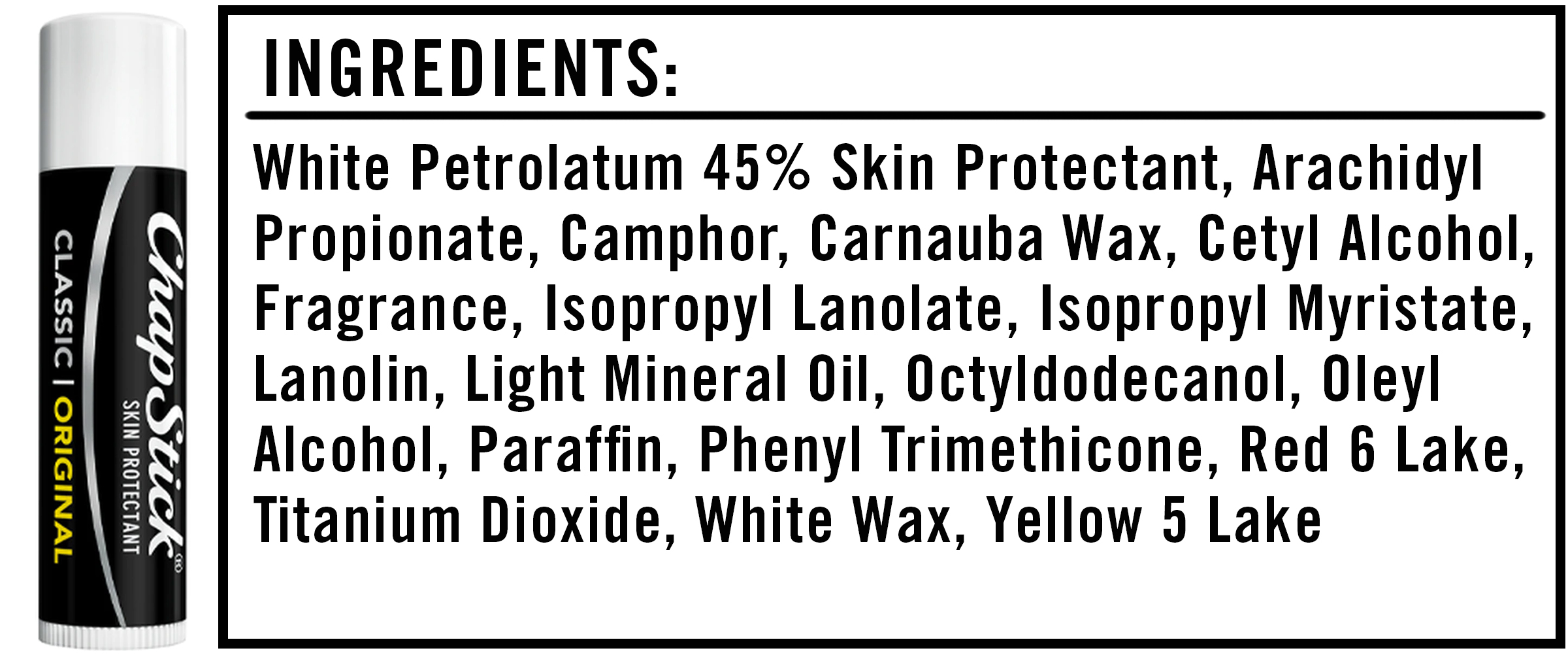We’re often told that you should never eat anything (or put anything on your body) if you don’t recognize everything on the ingredients list. But since most of us have no idea what xanthan gum or potassium benzoate are — or more importantly, what they’re doing to our bodies — we’re decoding the ingredients in the many things Americans put in (and on, or near) themselves.
This edition: Original ChapStick, which is made from 18 ingredients that we’ve broken down as they appear on the ChapStick website.
The Ingredients
1) White Petrolatum 45% Skin Protectant: Essentially, white petrolatum is a byproduct of petroleum drilling that can be used on your lips to seal in moisture and protect them from damaging and drying environmental pollutants. If you want to know more about white petrolatum — like why a British chemist poured acid on himself to convince people of its benefits — check out our full analysis of Vaseline.
2) Arachidyl Propionate: Arachidyl propionate is a semisolid wax that gives your lips a soft and smooth appearance. There’s some misinformation floating around which suggests that arachidyl propionate is derived from peanuts, and therefore should be avoided by those with peanut allergies. However, this is simply not the case.
3) Camphor: Camphor is usually derived from camphor trees — although it comes in synthetic variations, too — and has a menthol-like, nose-tingling fragrance. It basically serves to give you the impression that your ChapStick is working and is one of the ingredients that can make lip balm kind of addictive. Speaking of which, is ChapStick addictive? Not chemically. But ingredients like camphor can contribute to people using ChapStick more than they should.
4) Carnauba Wax: “Carnauba wax is a water insoluble substance used as a glazing, bulking and anticaking agent,” Dagan Xavier, ingredient expert and co-founder of Label Insight, told us during out analysis of the ingredients in Orbit White Spearmint Gum. It can be especially useful for carrying flavors and scents. This particular wax is sourced from the copernicia prunifera, a plant grown only in northeastern Brazil.
5) Cetyl Alcohol: A white, waxy chemical, cetyl alcohol softens the skin and can be used to thicken all sorts of cosmetics. Unlike many other alcohols, which can cause irritation and dryness, cetyl alcohol can be useful for soothing and healing dry skin.
6) Fragrance: Unfortunately, fragrance recipes are considered to be proprietary information, so finding out exactly what produces the smell of this ChapStick is virtually impossible. Double unfortunately, fragrances are a fairly common allergen and can cause rashes and redness in people with sensitive skin, so if you land in that group, consider keeping an eye out for unscented lip balms, instead.
7) Isopropyl Lanolate: Produced from lanolin (more on that ingredient momentarily), isopropyl lanolate acts as a lubricant, providing your skin with a glossy, soft and smooth appearance.
8) Isopropyl Myristate: Isopropyl myristate is a skin-conditioning agent that can be synthetically made or sourced from myristic acid, a naturally-occurring fatty acid. It can be particularly good at reducing the greasy feel caused by a high oil content in certain products and is generally considered to be safe. But people with oily skin beware: It tends to cause blackheads by blocking your pores.
9) Lanolin: Like we just mentioned, lanolin is a waxy substance produced by the skin glands of sheep to help condition their wool. It’s usually added to cosmetics for its skin-softening qualities, but watch out for this ingredient if you have sensitive skin: It’s notorious for causing allergic reactions.
10) Light Mineral Oil: Similar to white petrolatum, mineral oil acts as a barrier between the skin and environmental pollutants. It also helps your lips hold on to moisture.
11) Octyldodecanol: Octyldodecanol is a synthetic fatty alcohol used — in this case — as a skin-conditioning agent. It can also help prevent the ChapStick formula from separating into its oil and liquid components.
12) Oleyl Alcohol: Similar to octyldodecanol, oleyl alcohol is a fatty alcohol that gives the skin a smooth appearance and prevents other ingredients from separating.
13) Paraffin: Like white petrolatum and mineral oil, paraffin is a wax that helps the skin hold water.
14) Phenyl Trimethicone: A white, silicone fluid, phenyl trimethicone slows the loss of water from the skin by forming a barrier on the surface of the skin. It can also provide your lips with a slight sheen.
15) Red 6 Lake: Artificial colors have a bad reputation, but as physician and biochemist Cate Shanahan explained during our analysis of Doritos, studies arguing this are a bit flawed: They tend to employ more artificial colors than anyone would ever consume, especially in ChapStick.
16) Titanium Dioxide: Titanium dioxide prevents discoloration. Unfortunately, the European Chemical Agency has concluded that titanium dioxide may cause cancer when inhaled, although the miniscule amounts in ChapStick are most likely harmless.
17) White Wax: Another basic wax. Nothing to see here.
18) Yellow 5 Lake: Same as Red 6 Lake.
The Takeaway
ChapStick is pretty standard as far as lip balms go. It should work just fine, and none of the ingredients are necessarily anything to scoff at. However, if you want something simpler with fewer ingredients, plain old Vaseline works just fine, too.


